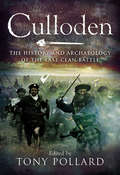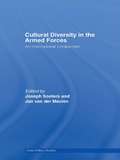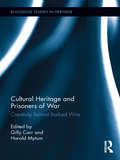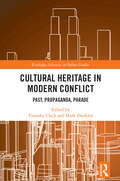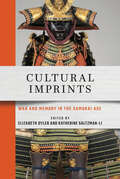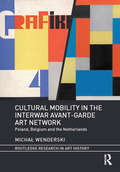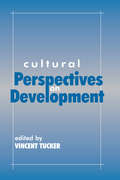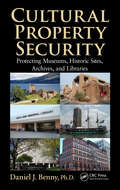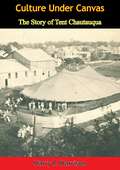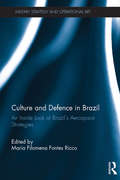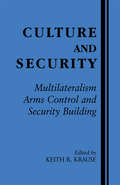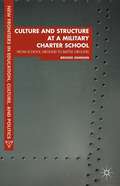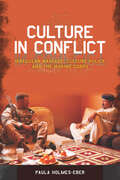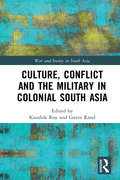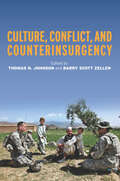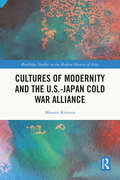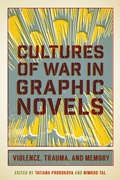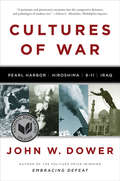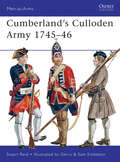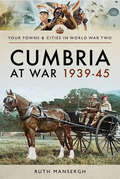- Table View
- List View
Culloden: The History and Archaeology of the Last Clan Battle
by Tony PollardA team of historians and archaeologists re-examine what happened at the Battle of Culloden between the Scottish Jacobites and Great Britain. In battle at Culloden Moor on April 16, 1746, the Jacobite cause was dealt a mortal blow. The power of the Highland clans was broken. And the image of sword-wielding Highlanders charging into a hail of lead delivered by the red-coated battalions of the Hanoverian army has passed into legend. The battle was a turning point in British history. And yet our perception of this critical episode tends to be confused by mistaken, sometimes partisan, views of the events on the battlefield. So, what really happened at Culloden? In this fascinating and original book, a team of leading historians and archaeologists reconsiders every aspect of the battle. They examine the latest historical and archaeological evidence, question every assumption, and rewrite the story of the campaign in vivid detail. This is the first time that such a distinguished team of experts has focused on a single British battle. The result is a seminal study of the subject, and it is a landmark publication of battlefield archaeology.Praise for Culloden&“Culloden is one of the best documented British battles and also one of the most mapped, yet the contributions to this fine volume have succeeded in finding new material.&” —Scotts Magazine (UK)
Cultural Diversity in the Armed Forces: An International Comparison (Cass Military Studies)
by Joseph Soeters Jan van der MeulenThis volume explores ethnicity and gender developments in relation to the military. In some countries, the armed forces have a long history in responding to ethnic diversity, while elsewhere it has come up only recently as a policy issue. An even-handed representation of ethnic minorities in the military is recognized as crucial for enhancing its social legitimacy and professional quality. The same can be said about the integration of women in the military, which during a few decades across the board has grown into more than just another issue of personnel policies. Indeed with regard to gender, the symbolism and sensitivities surrounding core identities are at stake – as with the presence of gays and lesbians in the military. Written by experts in the field, the chapters cover fourteen countries around the world: the USA, Canada, Bolivia, Ecuador, Brazil, South-Africa, Eritrea, India, Israel, Great Britain, France, Germany, Belgium and The Netherlands. Taken together, the armed forces of these countries offer a fascinating mix of similarities and differences in the ways they try to manage cultural diversity. Cultural Diversity in the Armed Forces will be of interest to students and scholars of military studies, sociology, gender and political science.
Cultural Heritage and Prisoners of War: Creativity Behind Barbed Wire
by Harold Mytum Gilly CarrThis book focuses on the numerous examples of creativity produced by POWs and civilian internees during their captivity, including: paintings, cartoons, craftwork, needlework, acting, musical compositions, magazine and newspaper articles, wood carving, and recycled Red Cross tins turned into plates, mugs and makeshift stoves, all which have previously received little attention. The authors of this volume show the wide potential of such items to inform us about the daily life and struggle for survival behind barbed wire. Previously dismissed as items which could only serve to illustrate POW memoirs and diaries, this book argues for a central role of all items of creativity in helping us to understand the true experience of life in captivity. The international authors draw upon a rich seam of material from their own case studies of POW and civilian internment camps across the world, to offer a range of interpretations of this diverse and extraordinary material.
Cultural Heritage in Modern Conflict: Past, Propaganda, Parade (Routledge Advances in Defence Studies)
by Timothy Clack Mark DunkleyThis edited volume offers an in-depth study of heritage and warfare from the perspective of defence studies. The book focuses on how, in different contexts, heritage can be a catalyst and target of conflict, an obstacle to stabilisation, and a driver of peace-building. It documents the changing role of heritage – in terms of both exploitation and protection – in various military capabilities, theatres, and operations. With particular concern for the areas of subthreshold and hybrid warfare, stabilisation, cultural relationships, human security, and disaster response, the volume reviews the historical relationship between heritage and armed conflict, including the roles of embedded archaeologists, safeguarding of ethics, and dislodgement and destruction of material culture. Various chapters in the book also demonstrate the value of understanding how state and non-state actors exploit cultural heritage across different defence postures and within both subthreshold and proxy warfare in order to achieve military, political, economic, and diplomatic advantages. This book will be of interest to students of defence studies, heritage studies, anthropology and security studies in general, as well as military practitioners.
Cultural Imprints: War and Memory in the Samurai Age
by Elizabeth OylerCultural Imprints draws on literary works, artifacts, performing arts, and documents that were created by or about the samurai to examine individual "imprints," traces holding specifically grounded historical meanings that persist through time. The contributors to this interdisciplinary volume assess those imprints for what they can suggest about how thinkers, writers, artists, performers, and samurai themselves viewed warfare and its lingering impact at various points during the "samurai age," the long period from the establishment of the first shogunate in the twelfth century through the fall of the Tokugawa in 1868. The range of methodologies and materials discussed in Cultural Imprints challenges a uniform notion of warrior activity and sensibilities, breaking down an ahistorical, monolithic image of the samurai that developed late in the samurai age and that persists today. Highlighting the memory of warfare and its centrality in the cultural realm, Cultural Imprints demonstrates the warrior's far-reaching, enduring, and varied cultural influence across centuries of Japanese history.Contributors: Monica Bethe, William Fleming, Andrew Goble, Thomas Hare, Luke Roberts, Marimi Tateno, Alison Tokita, Elizabeth Oyler, Katherine Saltzman-Li
Cultural Mobility in the Interwar Avant-Garde Art Network: Poland, Belgium and the Netherlands (Routledge Research in Art History)
by Michał WenderskiThis book explores the issue of cultural mobility within the interwar network of the European avant-garde, focusing on selected writers, artists, architects, magazines and groups from Poland, Belgium and Netherlands. Regardless of their apparent linguistic, cultural and geographical remoteness, their mutual exchange and relationships were both deep and broad, and of great importance for the wider development of interwar avant-garde literature, art and architecture. This analysis is based on a vast research corpus encompassing original, often previously overlooked periodicals, publications and correspondence gathered from archives around the world.
Cultural Perspectives on Development (European Association Of Development Research And Training Institutes (eadi), Geneva, Book Ser.)
by Vincent TuckerWhat does cultural analysis have to offer development studies? Is culture a new paradigm for the study of development or a minefield of theoretical confusion? Can we move beyond notions of global culture' and local culture' to a more refined notion of cultural processes?This collection of articles addresses these issues providing a diversity of approaches. Two themes in particular run through the contributions: the relationship between culture and political economy and the relationship between local and global processes.
Cultural Property Security: Protecting Museums, Historic Sites, Archives, and Libraries
by Daniel J. BennyThe protection and security of cultural properties is of primary concern to the thousands of federal, state, county, city, and private institutions entrusted with housing and displaying our national heritage and history of our society. Cultural property security is of global importance as well, with tens of thousands of institutions internationally
Culture Under Canvas: The Story of Tent Chautauqua
by Harry P. Harrison Karl DetzerIn 1904, a showman and Redpath Leyceum Bureau manager named Keith Vawter, put the main forms of entertainment of the time—comedy and culture—on the same platform in a travelling tent, “marrying the respectability of the Lyceum to the spangles of the stage,” and named the union “Chautauqua,” after an institution established permanently on Chautauqua Lake, New York.For the next thirty years, Chautauqua tents rolled back and forth and up and down America, pitching in pastures, school yards and courthouse squares. “They offered not only the soaring oratory of a William Jennings Bryan, but also music, drama, magic, art lessons, cooking classes, low comedy and high-minded debates. Millions of eager listeners under the “big top” canvas, hot with summer’s sun, perspired freely and soaked up both erudition and amusement.”This book, first published in 1958, takes a close look at the movement that allowed men to talk freely from this new informal platform, abandoning nineteenth-century taboos.
Culture and Defence in Brazil: An Inside Look at Brazil's Aerospace Strategies (Military Strategy and Operational Art)
by Maria Filomena Fontes RiccoThis volume examines the connection between culture and defence by providing an inside look at Brazil’s aerospace strategies. Brazil is becoming increasingly important geopolitically, and several studies have sought to further understanding of this new position in the international arena. This volume aims to provide a better understanding of the Brazilian nation, its security dilemmas, and how the country seeks to develop its defence training process and improve its professional military education. Organised into two parts, the chapters offer academic dialogues on several aspects of this topic, including public politics and the law, joint operations, human factors and the government interchanges with industry. The first section analyses Brazilian defence policy and strategy, discussing different aspects of aerospace power and Brazilian security perspectives. Chapters discuss the relationship between Brazil and the United States, which blend aspects of the generation of knowledge, science, technology and innovation, and point to economic issues and the Defence Industrial Base. Specific implications of the Brazilian air space, compared with Europe and the United States, also are exposed. In addition, a vision of cyberspace implications for the national power, a present-day question for the entire planet, is also presented. Thereafter, the second section looks at specific aspects of professional military education and explains the Brazilian approach to strengthening its aerospace power. This includes military education and performance, interdisciplinary studies, working jointly, multivariate analysis and cases. This book will be of much interest to students of military studies, defence studies, gender issues, crises management and decision making, Latin American politics and International Relations in general.
Culture and Human-Robot Interaction in Militarized Spaces: A War Story (Emerging Technologies, Ethics and International Affairs)
by Julie CarpenterExplosive Ordnance Disposal (EOD) personnel are some of the most highly trained people in the military, with a job description that spans defusing unexploded ordnance to protecting VIP’s and state dignitaries. EOD are also one of the first military groups to work with robots every day. These robots have become an increasingly important tool in EOD work, enabling people to work at safer distances in many dangerous situations. Based on exploratory research investigating interactions between EOD personnel and the robots they use, this study richly describes the nuances of these reciprocal influences, especially those related to operator emotion associated with the robots. In particular, this book examines the activities, processes and contexts that influence or constrain everyday EOD human-robot interactions, what human factors are shaping the (robotic) technology and how people and culture are being changed by using it. The findings from this research have implications for future personnel training, and the refinement of robot design considerations for many fields that rely on critical small group communication and decision-making skills.
Culture and Resistance: Conversations with Edward W. Said
by Edward W. Said David BarsamianEdward W. Said discusses the centrality of popular resistance to his understanding of culture, history, and social change. He reveals his latest thoughts on the war on terrorism, the war in Afghanistan, and the Israeli-Palestinian conflict.
Culture and Security: Multilateralism, Arms Control and Security Building
by Keith R. KrauseA comprehensive and empirically rich set of case studies that examine the impact of socio-cultural influences on multilateral arms control and security-building processes around the world.
Culture and Structure at a Military Charter School
by Brooke JohnsonTaking military charter schools as her subject, and drawing on years of research at one school in particular, Brooke Johnson explores the underpinings of a culture based on militarization and neoliberal educational reforms and probes its effects on individual identity and social interactions at the school.
Culture in Conflict: Irregular Warfare, Culture Policy, and the Marine Corps
by Paula Holmes-EberIn response to the irregular warfare challenges facing the U. S. in Iraq and Afghanistan in 2005, General James Mattis#151;then commander of Marine Corps Combat Development Command#151;established a new Marine Corps cultural initiative. The goal was simple: teach Marines to interact successfully with the local population in areas of conflict. The implications, however, were anything but simple: transform an elite military culture founded on the principles of "locate, close with, and destroy the enemy" into a "culturally savvy" Marine Corps. Culture in Conflict: Irregular Warfare, Culture Policy, and the Marine Corps examines the conflicted trajectory of the Marine Corps' efforts to institute a radical culture policy into a military organization that is structured and trained to fight conventional wars. More importantly, however, it is a compelling book about America's shifting military identity in a new world of unconventional warfare.
Culture in Conflict: Irregular Warfare, Culture Policy, and the Marine Corps
by Paula Holmes-EberIn response to the irregular warfare challenges facing the U. S. in Iraq and Afghanistan in 2005, General James Mattis#151;then commander of Marine Corps Combat Development Command#151;established a new Marine Corps cultural initiative. The goal was simple: teach Marines to interact successfully with the local population in areas of conflict. The implications, however, were anything but simple: transform an elite military culture founded on the principles of "locate, close with, and destroy the enemy" into a "culturally savvy" Marine Corps. Culture in Conflict: Irregular Warfare, Culture Policy, and the Marine Corps examines the conflicted trajectory of the Marine Corps' efforts to institute a radical culture policy into a military organization that is structured and trained to fight conventional wars. More importantly, however, it is a compelling book about America's shifting military identity in a new world of unconventional warfare.
Culture under Cross-Examination: International Justice and the Special Court for Sierra Leone
by Tim KelsallThe international community created the Special Court for Sierra Leone to prosecute those who bore the greatest responsibility for crimes committed during the country's devastating civil war. Tim Kelsall examines some of the challenges posed by the fact that the Court operated in a largely unfamiliar culture, in which the way local people thought about rights, agency and truth-telling sometimes differed radically from the way international lawyers think about these things. By applying an anthro-political perspective to the trials, he unveils a variety of ethical, epistemological, jurisprudential and procedural problems, arguing that although touted as a promising hybrid, the Court failed in crucial ways to adapt to the local culture concerned. Culture matters, and international justice requires a more dialogical, multicultural approach.
Culture, Conflict and the Military in Colonial South Asia
by Kaushik Roy Gavin RandThis book offers diverse and original perspectives on South Asia’s imperial military history. Unlike prevailing studies, the chapters in the volume emphasize both the vital role of culture in framing imperial military practice and the multiple cultural effects of colonial military service and engagements. The volume spans from the early East India Company period through to the Second World War and India’s independence, exploring themes such as the military in the field and at leisure, as well as examining the effects of imperial deployments in South Asia and across the British Empire. Drawing extensively on new archival research, the book integrates previously disparate accounts of imperial military history and raises new questions about culture and operational practice in the colonial Indian Army. This work will be of interest to scholars and researchers of modern South Asian history, war and strategic studies, military history, the British Empire, as well as politics and international relations.
Culture, Conflict, and Counterinsurgency
by Thomas H. Johnson Barry Scott ZellenCulture, Conflict, and Counterinsurgency
Cultures of Modernity and the U.S.-Japan Cold War Alliance (Routledge Studies in the Modern History of Asia)
by Masami KimuraCultures of Modernity and the U.S.-Japan Cold War Alliance reconsiders the origins of postwar U.S.-Japan relations by focusing on “modernization” ideologies that the Americans and the Japanese shared in the 1940s–early 1950s. Mobilizing a wealth of English and Japanese-language sources, the author identifies parallel groups of modernist thinkers in America and Japan – including politicians, bureaucrats, intellectuals, scholars, and journalists – and follows how different strands of thought played out within an evolving political environment, forming a “middle ground.” Despite their differences, both the Americans and the Japanese believed in the progressive view of history, considered Japan to be still underdeveloped, and therefore agreed on the advisability of democratizing Japan – which included constitutional reform. Whether proponents or opponents of the U.S.-Japan Cold War alliance system, they also shared the vision of Wilsonian internationalism and devised similar designs for a postwar Asian order where Japan would rejoin. Thus, by showing how the confluence of modernist cultures helped forge a postwar relationship between the two, this study contributes to the field of postwar U.S.-Japan relations by supplementing and reorienting the scope of scholarship, one that has been predominantly America-centered and framed along the line of diplomatic narratives informed by Cold War politics.
Cultures of War in Graphic Novels: Violence, Trauma, and Memory
by Nimrod Tal Tatiana Prorokova Iain A. MacInnes Kenton Worcester Emir Pasanovic Harriet E.H. Earle James Kelley Joe Lockard Christina M. Knopf Peter C. Valenti Silvia G. Kurlat Ares Yasmine Nachabe TaanCultures of War in Graphic Novels examines the representation of small-scale and often less acknowledged conflicts from around the world and throughout history. The contributors look at an array of graphic novels about conflicts such as the Boxer Rebellion (1899-1901), the Irish struggle for national independence (1916-1998), the Falkland War (1982), the Bosnian War (1992-1995), the Rwandan genocide (1994), the Israel-Lebanon War (2006), and the War on Terror (2001-). The book explores the multi-layered relation between the graphic novel as a popular medium and war as a pivotal recurring experience in human history. The focus on largely overlooked small-scale conflicts contributes not only to advance our understanding of graphic novels about war and the cultural aspects of war as reflected in graphic novels, but also our sense of the early twenty-first century, in which popular media and limited conflicts have become closely interrelated.
Cultures of War: Pearl Harbor / Hiroshima / 9-11 / Iraq
by John W. DowerFinalist for the 2010 National Book Award in Nonfiction: The Pulitzer Prize-winning historian returns with a groundbreaking comparative study of the dynamics and pathologies of war in modern times. Over recent decades, John W. Dower, one of America’s preeminent historians, has addressed the roots and consequences of war from multiple perspectives. In War Without Mercy (1986), winner of the National Book Critics Circle Award, he described and analyzed the brutality that attended World War II in the Pacific, as seen from both the Japanese and the American sides. Embracing Defeat (1999), winner of numerous honors including the Pulitzer Prize and the National Book Award, dealt with Japan’s struggle to start over in a shattered land in the immediate aftermath of the Pacific War, when the defeated country was occupied by the U.S.-led Allied powers. Turning to an even larger canvas, Dower now examines the cultures of war revealed by four powerful events—Pearl Harbor, Hiroshima, 9-11, and the invasion of Iraq in the name of a war on terror. The list of issues examined and themes explored is wide-ranging: failures of intelligence and imagination, wars of choice and “strategic imbecilities,” faith-based secular thinking as well as more overtly holy wars, the targeting of noncombatants, and the almost irresistible logic—and allure—of mass destruction. Dower’s new work also sets the U.S. occupations of Japan and Iraq side by side in strikingly original ways. One of the most important books of this decade, Cultures of War offers comparative insights into individual and institutional behavior and pathologies that transcend “cultures” in the more traditional sense, and that ultimately go beyond war-making alone.
Cultures, Communities, and Conflict
by Paul Stortz E. Lisa PanayotidisCultures, Communities, and Conflict offers provocative, cutting-edge perspectives on the history of English-Canadian universities and war in the twentieth century. The contributors explore how universities contributed not only to Canadian war efforts, but to forging multiple understandings of intellectualism, academia, and community within an evolving Canadian nation.Contributing to the social, intellectual, and academic history of universities, the collection provides rich approaches to integral issues at the intersection of higher education and wartime, including academic freedom, gender, peace and activism on campus, and the challenges of ethnic diversity. The contributors place the historical university in several contexts, not the least of which is the university's substantial power to construct and transform intellectual discourse and promote efforts for change both on- and off-campus.With its diverse research methodologies and its strong thematic structure, Cultures, Communities, and Conflict provides an energetic basis for new understandings of universities as historical partners in Canadian community and state formation.
Cumberland's Culloden Army 1745-46
by Gerry Embleton Stuart ReidIn August 1745 Charles Edward Stuart, the 'Young Pretender', landed in Scotland and sparked the Second Jacobite Rising. The Jacobite forces seized Perth, then Edinburgh, where they proclaimed the Young Pretender's father King James VIII; they trounced their Hanoverian opponents at Prestonpans and crossed into England, getting as far south as Derby before withdrawing into Scotland. Far from universally popular north of the border, the Jacobite army bested another Hanoverian army at Falkirk and besieged Stirling, only to be routed by the Duke of Cumberland's army at Culloden in April 1746, a crushing defeat that ended any prospect of a Stuart restoration.Youngest son of Britain's Hanoverian king George II, the victorious general was lauded by his supporters while being reviled by his opponents as 'Butcher' Cumberland. His polyglot army, the subject of this book, included English regular Line infantry, cavalry, artillery, marines, and Scottish infantry (more Scots served on King George's side than followed 'Bonnie Prince Charlie'); English and Scottish 'provincial' infantry and cavalry regiments; and Hanoverian, Hessian, Dutch and Swiss infantry, cavalry and artillery.Featuring full-colour artwork depicting the distinctive uniforms of Cumberland's men, this exhaustively researched study offers a wealth of detail of regimental strengths and casualties and includes an extended chronology that places individual units in specific places throughout the campaign that culminated at Culloden.
Cumbria at War, 1939–45 (Your Towns & Cities in World War Two)
by Ruth Mansergh&“A comprehensive view of the important part Cumbria played in WWII, including a detailed look at the warships built in the Barrow Yard.&” —Firetrench The outbreak of war marked a new era for the people of Cumbria. Many young men and women enlisted in the Forces, while older people joined the Home Guard or became Air Raid Precaution Wardens. Children from cities were sent to Kendal to escape the threat of bombing raids, members of the Women&’s Land Army began to arrive on at the local farms, and Silloth airfield near Carlisle trained thousands of pilots from allied countries. The first sign of German interest in the important shipbuilding town of Barrow-in-Furness was in May 1936, when a rigid airship and passenger aircraft flew very low and slowly over the Furness rooftops. Vickers shipyard became a target for enemy bombing and eventually more than 10,000 houses were damaged or destroyed by the Luftwaffe during the Barrow Blitz that took place during April and May 1941. Extensively researched, the book takes a detailed look at the ships built in Barrow, memorials in the city of Carlisle and towns and villages across Cumbria, and remembers the brave dead of Second World War. Overall, this is a poignant testimony to the momentous efforts, bravery, self-sacrifice and determination of the people of Cumbria during the Second World War, who sought to find normality in a reality so far removed from anything they had ever known. &“In this fascinatingly good read, Ruth has captured the spirit and uncertainty of all Cumbrians in those stressful years.&” —Cumbria Family History Society
